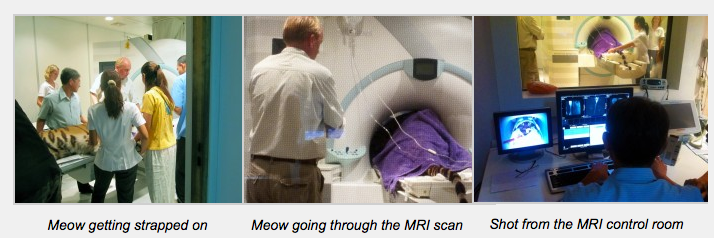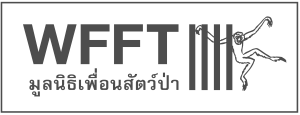After more than a year of slowly getting to know each other, we are thrilled to announce these rescued tigers have finally moved in together.
MEOW! A tiger undergoing an MRI scan

Care for the wild sponsors Meows further treatment!
Our Tiger, Meow, was rescued in 2001 by WFFT (Wildlife Friends Foundation Thailand), from a gas-station in Central Thailand. Meow was kept on a chain at this station, behind the fuel pumps, where people filling up their cars could touch the tiger (cub), and have their picture taken with him. When Meow fell critically ill at the age of 18 months, he was taken to the WFFT Wildlife Rescue Centre. After 4 months, Meow started to improve, so his owner allowed Meow to be handed over to WFFT. Over the years, Meow gained strength, and was able to move around his large enclosure. He had always shown neurological signs, and we were unable to find the cause of that. Over the years, Meow was treated with medication and physiotherapy, resulting in a relatively happy and healthy tiger. The cause for Meow’s unsteady walking was suspected to be an issue with his central nervous system, something that we could only treat with medication and food supplements. In those days, Meow was taken for x-rays, but we did not have the opportunity to get a brain scan (CT) or even think about an MRI (Magnetic Resonance Imaging), as it just wasn’t possible at that time, and that place.
Towards the end of 2011, Meow’s health started to deteriorate. He became less active, and lost his appetite. This resulted in further deterioration of his muscles, and through blood analysis we found some abnormalities in his organ function. By the end of October, Meow was not able to stand up on his own anymore, and became frustrated with his inability to move around. Several veterinarians from abroad offered to help with Meow, but unfortunately these treatments were unsuccessful. Meow was put on heavy medication, resulting in a rapid decline in his health, especially mentally. We were advised to immediately euthanise Meow, as he hadn’t responded to treatment, due to the lack of diagnoses.
I, Edwin Wiek, have lived in Thailand for 22 years, and I am aware of the local culture, and the beliefs that euthanasia “is not accepted” within the Buddhist culture, in Thailand. On the other hand, I work, and live, with dozens of foreign volunteers and medical specialists that feel completely different on this issue. While some Thai people will keep an animal alive under any circumstances, and will not take its suffering or pain into consideration (even if they are aware that the animal will not recover), I also get confronted from foreign vets and volunteers that come and help out, who favour euthanasia every step of the way. In some cases even if there is a chance of recovery. In the case of Meow, we did not have all the answers, and we did not have a clear diagnosis. So we decided to change Meows medication, and start doing intensive physiotherapy, just like we did 10 years ago. We soon saw a change in his behaviour. He was very happy to go in the water again, and within a week he regained enough strength to stand in the water. A few weeks later, he was able to walk with the support of several keepers, followed by the ability to swim on his own in the lake with only one keeper alongside of him. Meow was back to his old habit of eating 4-6 kilos of meat a day, and was recently seen holding himself up, and grooming his body. Previously to this, Meow was taken off his painkillers, and was only receiving food supplements and vitamins. So here I am facing a tiger that is showing a positive spirit, great appetite, showing improvement every week, but not being able to stand, or walk on his own. There were suggestions from two different sides: Put him to sleep or continue the current treatment. Both options did not appeal to me. I felt we had to do better, but how?
It was decided that we would continue the treatment, while we tried to find the answers, whatever it would take. If Meow didn’t start to improve, that would be the end, but first we had to get an accurate diagnosis. In December, Meow was again taken for xrays, and we found some abnormalities in his spine and neck. We knew that something was wrong, but we needed more diagnostics to get a clearer picture. What if we could see this in more detail? How can we? A visiting veterinarian from Malaysia with decades of experience made a suggestion: What if we could get a Myleogram of his spine, or even better an MRI! We might find the cause of his problem, and know if it is treatable, or if we were fighting a losing battle. The Myelogram was the first, and easiest option, however I wanted to try to go for the best, the MRI. It took me two days of calling around to people, hospitals, clinics and specialists, with no success, until I got in touch with Dr. Suwicha from Chulalongkorn University. I hadn’t spoken to him for several years, but he immediately told me he would try to help Meow. Within the same day, Dr Suwicha called me back to tell me he had found a hospital with MRI facilities, that would allow us to take Meow, but it would have to take place at night time. The management was very happy to help us, but they were concerned that a tiger on a stretcher, even under sedation, would scare the human patients in the hospital. We made an appointment for Wednesday the 4th of January, at 9PM. The MRI centre was in Bangkok, so we needed to travel approx 2.5 hours from our rescue centre.
On that Wednesday night, we arrived at the MRI Hospital in western Bangkok, just in time for the MRI scan. We were all aware that putting a tiger under anaesthesia for a long period of time (he was not to move even an inch, during his 40 minute scan), was going to be very risky. We had to accept the reality that he might die on the table, which was a difficult thought. Meow was very calm and co-operative on the journey, and did not require any sedation until we arrived at the hospital. It helped that Nom, his animal keeper, who had cared for him for over 10 years, never left his side. For the trip, we made him a comfortable bed with a mattress on the back of the truck, but once we arrived at the clinic he was put on a stretcher for humans. This was actually a bit too small for his large body, but we managed. We had a very experienced vet team (5 veterinarians and Lucy Clark, our veterinary nurse) who started with preparations for the sedation. Meow was still very calm and relaxed, even under all the bright lights, and a crowd of hospital staff who couldn’t believe their eyes. The first injection of sedatives, were administered. Within minutes of receiving his initial sedation, Meow stopped breathing. He still had a heart beat, but he was holding his breath, and his blood oxygen levels dropped dangerously low. For a split second I thought that this was it, he was going to leave us right here, on a stretcher. He urgently needed an endotracheal tube placed down his throat, and oxygen. The vet team had a meeting before the procedure to discuss all the risks and emergency procedures, so they were prepared for anything. To every ones relief, Meow was stabilized and started breathing normally. His heart never stopped beating, but it felt like forever that he had stopped breathing. Meow was then moved into the MRI room. The electricity then went off, another setback, but it was for only a couple of minutes, and the MRI had to reboot for 10 minutes before we could finally start.
The MRI scan took less then 40 minutes, and Meow did really well! His breathing, heartbeat, blood oxygen level & reflexes were monitored closely by Lucy, and there were no complications. Thankfully, Meow was very stable and didn’t move during the scan, so the procedure went very smoothly. We then received the good news – We had confirmed diagnoses. Meow has a fracture between Cervical 1 & 2 in his neck, and the pressure from the fracture is causing a spinal cord compression. At first i thought that this would not be treatable in Thailand, but at least we now knew what was wrong with him, and we could re-assure ourselves that we had done everything we could. Meow was then moved outside, and the team started recovering him from the sedation, which was expected to take up to one hour.
Soon after, the veterinary team had a meeting in the MRI control room, with access to all files and print outs of the MRI scan. After accessing the results, a discussion took place on Meows current medical state, and the surgical options that are available in Thailand. The veterinarians unanimously decided that spinal surgery was the only option, and there would be a 75% chance of him recovering. Within the next week, a date will be confirmed for the surgery, which will take place at Chulalongkorn University, with an extensive team of Surgeons & veterinary professionals.
Care for the wild international (CFTWI), based in the UK have sponsored the food and care for Meow over the last 3 years and have now also offered to pay for Meow’s medical bills of the MRI and spinal surgery. We are very thankful to CFTWI for this continued support of Meow and our work!




